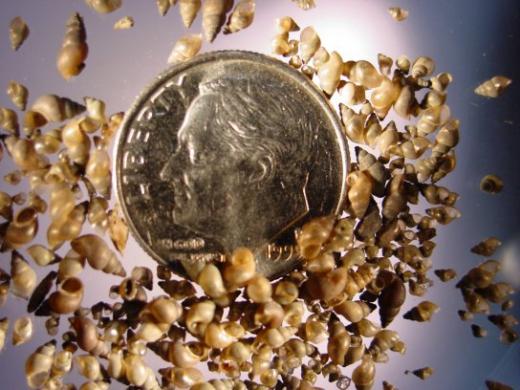New Zealand Mudsnail does not appear to be spreading
This is a press release concerning the sampling of various streams around the state for the presence of New Zealand Mudsnails:
FOR IMMEDIATE RELEASE
March 3, 2015
No genetic evidence of invasive snail found outside one Wisconsin stream
MADISON, Wis. — Results from a multistate environmental DNA sampling effort did not detect any genetic evidence of New Zealand mudsnails in Illinois, Iowa or Wisconsin outside of Black Earth Creek in Dane County, Wis.
The New Zealand mudsnail was found in Dane County’s Black Earth Creek in 2013 – the first appearance of snail in the Midwest outside of the Great Lakes basin. Although they measure just one-eighth of an inch in length, New Zealand mudsnails multiply quickly and alter resources used by trout and other stream animals.
Upon discovery of the New Zealand mudsnail in a Midwest trout stream, aquatic invasive species program coordinators from all three states developed a joint plan to identify the range of the invader. With the help of a $30,000 grant from Mississippi River Basin Panel on Aquatic Nuisance Species, the Wisconsin DNR was able to coordinate the collection of water samples across 45 sites in Illinois, Iowa and Wisconsin.
The samples were then screened for traces of New Zealand mudsnail DNA by the U.S. Geological Survey Upper Midwest Environmental Sciences Center in La Crosse and the University of Wisconsin–Stevens Point. These genetic sampling techniques have been shown to be more sensitive in detecting rare organisms than conventional sampling methods.
Maureen Ferry, the Wisconsin DNR aquatic invasive species monitoring coordinator, said the project has provided a baseline understanding of the distribution of these snails. “We can be reasonably confident that New Zealand mudsnail populations do not exist at the sites we sampled,” said Ferry. “This tells us that continued prevention efforts are worthwhile in trying to stop the spread of this harmful invader.”
Ferry said the research also provided insight on the effective use of eDNA monitoring for invasive species in streams. “We learned a great deal through this multistate effort and continued to refine our eDNA techniques to augment traditional monitoring efforts,” Ferry said. “Both methods combined greatly increase our ability to detect invasive species.”
Aquatic invasive species program managers are encouraged by the results of the sampling effort. The limited distribution of New Zealand mudsnails in one stream in Wisconsin gives managers time to implement awareness campaigns to help water users prevent the spread of the snails outside of their known location.
“The Stop Aquatic Hitchhikers guidance of cleaning debris and draining water from gear are good first steps,” said Bob Wakeman, aquatic invasive species program coordinator for the Wisconsin DNR. However, given the hardiness of these snails, additional steps are encouraged, including scrubbing gear with a brush to remove the hard-to-see snails, freezing gear or soaking it in hot, 120° F water.
“By taking these steps,” said Wakeman, “all water users can protect Wisconsin waters from the impacts of invasive species.”
To learn more, visit DNR.wi.gov and search “New Zealand mudsnail.” For the complete USGS report on the eDNA monitoring project, visit http://goo.gl/rZVh7S.
CONTACT: Maureen Ferry, DNR aquatic invasive species monitoring coordinator, 608-261-6450; Maureen.Ferry@wisconsin.gov


